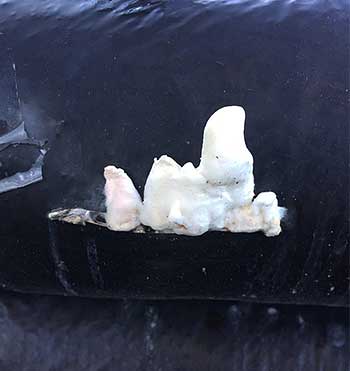High humidity is needed for cultivating oyster mushrooms, at least 82-85%, and for some strains even 87-89%.
The humidity required for oyster mushrooms can be created in various ways. We will look at different types of humidifiers.
A very important point is that any nozzles should be placed not in the growing chamber, but in the ventilation system.
Their disadvantage is that the drop is quite large. Such drops do not evaporate completely and often settle on the mushroom caps. This is not dangerous for mushrooms larger than 2 centimeters. But, if drops fall on mushrooms in the pin stage, the pin will stop growing and begin to rot.
In my opinion, this is the most successful option among injectors. They adjust well and produce fine water dust with droplet sizes of 20-30 microns. For oyster mushrooms this is what you need.
- high cost of the system itself and water treatment,
- non-demountable design,
- inability to replace one nozzle in the belt.
Before purchasing them, you need to evaluate how feasible it is.
Sellers of high pressure systems do not like to mention water treatment. High pressure nozzles require maximum purification of water from salts, and not just from mechanical particles. And such a cleaning installation costs from $1000, no less.
If, for example, your water is very soft and you only need mechanical cleaning filters and you will buy a high-pressure pressure system, be sure to make sure that in this model you can replace a separate nozzle, and they themselves are collapsible and can be cleaned.
There are two ways to create real fog in your grow room.
The first method is used quite rarely and only on very large mushroom farms. This is the production of steam using a steam generator. Steam flows through pipes into the central air duct of each chamber and the humidity is controlled using dampers in the steam pipe.
The second method is the so-called cold steam, which is produced by the plates of ultrasonic humidifiers. As a result of vibration, water particles turn into small droplets less than 5 microns in size. We feel these drops like a thick mist.
An extensive description with recommendations for choosing the systems and devices themselves is in my book “Ready-made tables with ventilation calculations”.
Dry air should not escape from the air ducts.
Even if the humidification nozzles are located next to the outlets of the air flow from the air duct, it will not have time to mix with moisture and become saturated with it.
Therefore, a separate air preparation box is needed to mix fresh and recirculated air and saturate it with moisture.

This can be either a separate room or an extension in the form of a box in the ventilation system for installing a humidifier. When using an Ultrasonic humidifier, you simply point the tube into the duct in the direction of air flow.
And you can water the floors only as a supplement to the incoming moist air.
But it is necessary to weigh the pros and cons. Immediately at the moment of watering, the humidity rises sharply and then gradually drops.
If there are primordia in the chamber, condensation may fall on them - they will either die or some of them will turn yellow.
When water from nozzles or irrigation gets on a mushroom bud that has not yet grown from the perforation, ugly white growths similar to foam may develop, as in the photo.
It is possible to distribute the fog evenly in the mushroom room only through branching air ducts. It is important for us to saturate the air entering the growing room with moisture.
And when using humidifiers in the room itself, we have a separate warm, dry stream and a separate fine mist, which partially dissolves in the stream and partially falls on the growing oyster mushrooms.
If you use a timer to turn on devices and the humidifiers work for a while and then turn off, there will definitely be a difference in humidity in the room.
It will cause uneven humidification of the incoming air flow, and, as a result, problems with the growth and appearance of oyster mushrooms.
You can lower the temperature in the growing room, but not below 12-13 degrees Celsius. Let's say at 15 degrees you were able to raise the humidity to only 78%. If you lower the temperature to 13.5, the air humidity will be 85%. Of course, this is a temporary measure, but you can set up additional humidification and raise the temperature in the room again.
You need to lower the temperature slowly by 0.5 degrees in one to two hours.
Psychrometers are used to measure humidity. You can read about them on specialized websites.
In general, I can note that humidity measuring instruments are available in two types: expensive and low-quality. The choice is yours.
When the question arises, “what kind of moisture meter is needed for growing mushrooms at home?” - they buy mostly Chinese, after three or four months they buy again, again Chinese, but cheap. If you bought and threw away a cheap device five or six times, count how much you spent. Would it be enough for a real, normal sensor?
Expensive psychrometers have digital temperature sensors and the ability to connect a controller to automatically regulate the process.
Hygrometers should not be used in conditions of high humidity; they do not work correctly in this range.
The most important condition for high yields of heavy, fleshy mushrooms of commercial quality is stable humidity during the entire fruiting period.
Craftsmen produce controllers based on the Arduino platform. Such a controller is connected to two digital temperature sensors, one of which (the so-called wet thermometer) is located in distilled water.
It is enough to set the switch-on and switch-off point for the humidifier, and the device will regulate the humidity itself, depending on the amount of moisture in the growing chamber.
There are also commercially available humidity sensors with built-in controllers, but they are more expensive.
For high-quality regulation of humidification conditions, it is necessary that some part of the system sprays water constantly, maintaining the background humidity specified by the technologist.
The other part starts working automatically when there is a lack of moisture. Then changes in humidity will not be so significant.
It is necessary to understand that the most common reason for low yields even on a high-quality substrate is the rotting and drying out of primordia and small mushrooms due to moisture fluctuations.
